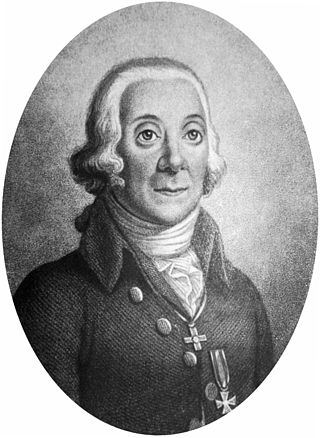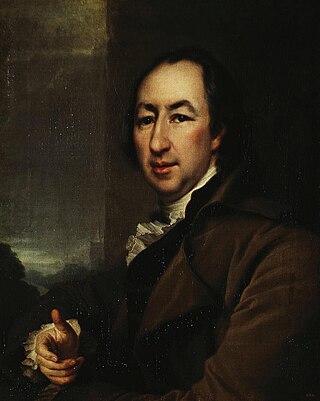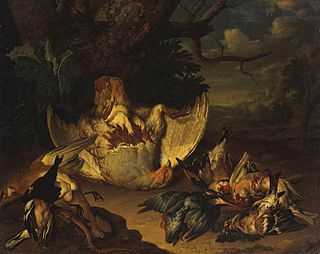Events
| | This section needs expansion. You can help by adding to it. (July 2016) |
| Years in Russia: | 1764 1765 1766 1767 1768 1769 1770 |
| Centuries: | 17th century · 18th century · 19th century |
| Decades: | 1730s 1740s 1750s 1760s 1770s 1780s 1790s |
| Years: | 1764 1765 1766 1767 1768 1769 1770 |
Events from the year 1767 in Russia
| | This section needs expansion. You can help by adding to it. (July 2016) |
| | This section needs expansion. You can help by adding to it. (July 2016) |

Peter Simon Pallas FRS FRSE was a Prussian zoologist, botanist, ethnographer, explorer, geographer, geologist, natural historian, and taxonomist. He studied natural sciences at various Universities in early modern Germany and worked primarily in the Russian Empire between 1767 and 1810.
An exarchate is any territorial jurisdiction, either secular or ecclesiastical, whose ruler is called an exarch. Byzantine Emperor Justinian I created the first exarchates during his invasion of the former Western Roman Empire, and the term is still used for naming some of the smaller communities of Eastern Rite Catholics as well as Eastern Orthodox Christians.

Pavel Vasilyevich Chichagov or Tchichagov was a Russian military and naval commander of the Napoleonic Wars.

Prince Michał Hieronim Radziwiłł was a Polish nobleman, politician, diplomat and member of the Polish-Lithuanian Radziwill family. He was a Knight of the Order of the White Eagle and a holder of the Order of the Black Eagle. His paternal great-grandfather was Dominik Mikołaj Radziwiłł.
The Kamchadals inhabit Kamchatka, Russia. The name "Kamchadal" was applied to the descendants of the local Siberians and aboriginal peoples who assimilated with the Russians. The descendants of the mixed-blood Russian settlers in 18th-19th century are called Kamchadals these days. The Kamchadals speak Russian with a touch of local dialects of the aboriginal languages of Kamchatka. The Kamchadals engage in fur trading, fishing, market gardening and dairy farming, and are of the Russian Orthodox faith. The Kamchadal language was a Kamchatka creole with Russian and indigenous elements.

Sava Petrović was the Metropolitan of Cetinje between 1735 and 1781, ruling what is known in historiography as the Prince-Bishopric of Montenegro; the polity in the hands of the Petrović-Njegoš dynasty. He succeeded his relative Danilo I as Metropolitan in 1735, having served as Danilo's coadjutor since the 1719, when he was consecrated by Serbian Patriarch Mojsije I.

The Hypatian Codex is a compendium of three Rus' chronicles: the Primary Chronicle, Kievan Chronicle and Galician-Volhynian Chronicle. It is the most important source of historical data about Kievan Rus'. The language of this work is Old Church Slavonic with many East Slavisms.

Nikolay Ivanovich Novikov was a writer and philanthropist most representative of his country's Enlightenment. Frequently considered to be the first Russian journalist, he aimed at advancing the cultural and educational level of the Russian public.

The Eyalet of Childir or Akhalzik was an eyalet of the Ottoman Empire in the Southwestern Caucasus. The area of the former Çıldır Eyalet is now divided between Samtskhe-Javakheti and the Autonomous Republic of Adjara in Georgia and provinces of Artvin, Ardahan and Erzurum in Turkey. The administrative center was Çıldır between 1578 and 1628, Ahıska between 1628 and 1829, and Oltu between 1829 and 1845.
Radom Confederation was a konfederacja of nobility (szlachta) in the Polish–Lithuanian Commonwealth formed in Radom on 23 June 1767 to prevent reforms and defend the Golden Liberties. It was formed by Russian envoy to Poland Nicholas Repnin and backed by the Russian Imperial Army as a response of Catholic nobility to the earlier Protestant confederations of Slutzk and Toruń, approximately 74,000 nobles declared their support for Radom Confederation.
Events from the year 1855 in France.

Andrzej Stanisław Kostka Młodziejowski (1717–1780), of Ślepowron coat of arms, was a Polish–Lithuanian nobleman, politician and priest. Bishop of Przemyśl (1766–1768), bishop of Poznań (1768–1780), Deputy Chancellor of the Crown (1746–1767), Great Chancellor of the Crown (1767–1780).

Panagiotis Benakis was a Greek businessman from Kalamata in the 18th century, during the Ottoman rule over Greece, he was in contact of Catherine the Great during the Orlov Revolt.

The Nikon Chronicle is a compilation of Russian chronicles undertaken at the court of Ivan the Terrible in the mid-16th century. The compilation was named after Patriarch of Moscow and all Rus' Nikon, who owned a copy. In the 18th century it was published under the name The Russian Chronicle According to Nikon's Manuscript.

Events from the year 1718 in Russia

The First Little Russia Governorate or Government of Malorossiya was created by Russian authorities in 1764–65 after the abolition of Cossack Hetmanate in Ukrainian lands incorporated into the Russian Empire. The (First) Little Russia Governorate was governed by Pyotr Rumyantsev.
Arsenije Plamenac was the Metropolitan of Cetinje between 1781 and 1784, earlier the co-adjutor to Metropolitan Sava Petrović during the reign of Šćepan Mali (1767–73). Plamenac (Plamenać) was from Crmnica, and belonged to the tribe's most notable brotherhood, the Plamenac. His father, Raič, was a priest. His maternal uncle was Sava Petrović. Following the footsteps of his father, and being the nephew of Sava, he quickly elevated through the monastic ranks, becoming a hegumen before his ordination. Sava intended to appoint him his successor in 1766, but was met with opposition from the Montenegrin tribes. The tribes accepted Arsenije after Sava had gained the support of Šćepan Mali, an impostor of Peter III of Russia who sought to rule Montenegro. Šćepan Mali supported Plamenac because he felt at home in Crmnica, and believed he would more easily take control of the whole of Montenegro by the side of Plamenac than the Petrović. Vasilije Brkić, the Patriarch of Peć, who had fled to Montenegro, consecrated Plamenac as a bishop in 1767. After his death, he was succeeded by Petar I Petrović Njegoš.
Events from the year 1714 in Russia
![]() Media related to 1767 in Russia at Wikimedia Commons
Media related to 1767 in Russia at Wikimedia Commons